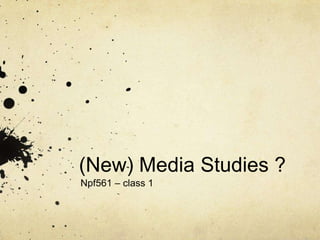
NPF561: Class 1: (New) Media Studies?
- 1. (New) Media Studies ? Npf561 – class 1
- 2. What Theories do you study ? In groups of three create a list that tells me: Who are the key experts in your field? What are the key texts in your field?
- 3. Who are the key experts in your field?
- 4. Who are the key texts in your field?
- 5. Media Studies Media studies is an academic discipline and field of study that deals with the content, history and effects of various media; in particular, the 'mass media'. The subject varies greatly in theoretical and methodological focus, but may be broadly divided into three interrelated areas: the critique of artistic styles and aesthetic forms (genre, narrative, and so on), the study of the production process (e.g. technologies and markets), and sociological analysis (of ideological effects, reception and consumption, etc.). Media studies draw on traditions from both the social sciences and the humanities, and overlap in interests with related disciplines like mass communication, communication, communication sciences and communication studies. Researchers develop and employ theories and methods from disciplines including cultural studies, rhetoric, philosophy, literary theory, psychology, political science, political economy, economics, sociology, anthropology, social theory, art history and criticism, film theory, and information theory. Source: http://en.wikipedia.org/wiki/Media_studies
- 6. New Media Studies? New media studies is a fairly recent academic discipline that explores the intersections of computing, science, the humanities, and the visual and performing arts. Janet Murray, a prominent researcher in the discipline, describes this intersection as "a single new medium of representation, the digital medium, formed by the braided interplay of technical invention and cultural expression at the end of the 20th century...." In a course on New Media Studies, students are exposed to ideas and insights on media from communication theorists, programmers, educators, and technologists.Among others, the work of Marshall McLuhan is viewed as one of the cornerstones of the study of media theory. McLuhan’s slogan, "the medium is the message" (elaborated on his 1964 book, Understanding Media: The Extensions of Man), [1] calls attention to the intrinsic effect of communications media. A program in New Media Studies may incorporate lessons, classes, and topics within Communication, Journalism, Computer Science, Programming, Graphic Design, Web design, Human-computer interaction, Media theory, English, and other related fields. Source: http://en.wikipedia.org/wiki/New_media_studies
- 7. Who are the key experts in your field?
- 8. Group Question 2 What is the role of the internet and new digital media, in the current media landscape? Are ethics important?
- 9. Case Study: Search engine reddit: the voice of the internet -- news before it happens WikiLeaks wars Domain Name war http://feeds.tvo.org/tvo/searchengine http://itunes.apple.com/ca/podcast/search-engine-from-cbc-radio/id263177400
- 10. Group Question 3 What author would you read that deals with these Internet and new digital media phenomenon?
- 11. 2007: 2.0 becomes acknowledged David Gauntlett proposed Media Studies 2.0 as a new framework The traditional form of media studies teaching and research fails to recognize : the changing media landscape in which the categories of 'audiences' and 'producers' blur together, new research methods and approaches they require.
- 12. Outline of difference Part 1
- 13. Outline of difference Part 2
- 14. Outline of difference Part 3
- 15. Media Studies 2.0 in practice Participatory media making: in 1995 Gauntlett handed children video cameras to make films about their responses to the environment, instead of just interviewing them (Gauntlett, 1997), and has continued through various projects, culminating most recently in the book Creative Explorations: New approaches to identities and audiences (2007), which describes – amongst other things – my study in which people were invited to build metaphorical models of their identities in Lego. Other instances of Media Studies 2.0 would include: The title of the journal Participations (launched 2003), an 'audience studies' journal that manages to avoid calling them 'audiences' – in its main title at least, although the subtitle 'Journal of Audience and Reception Studies' offers a perhaps inevitable translation into the language we are trying to get away from; The forthcoming conference Transforming Audiences, which seeks to undermine its own title by questioning the traditional approach to people who 'produce' media and people who 'use' media; Joke Hermes's book Reading Women's Magazines (1995), one of the first texts to demonstrate that Media Studies tended to over-emphasise its own consumption models; Studies by Sonia Livingstone and by David Buckingham, in the past few years, which have rejected passive models of media consumption; More active participation, such as Campaigns Wikia, based on the idea that 'If broadcast media brought us broadcast politics, then participatory media will bring us participatory politics'; William Merrin's blog, as mentioned above.
- 16. What does this mean to you? In groups of three, discuss whether this model is important to new media? Does Gaunlett’s Media Studies 2.0 framework apply your current practices? If yes, why and how? If no, why and how? What history and Theory framework should you abide by?
